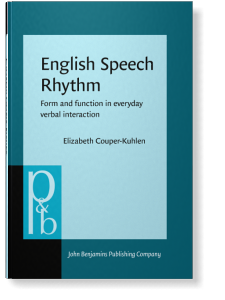English Speech Rhythm
Form and function in everyday verbal interaction
Author
This monograph reconsiders the question of speech isochrony, the regular recurrence of (stressed) syllables in time, from an empirical point of view. It proposes a methodology for discovering isochrony auditorily in speech and for verifying it instrumentally in the acoustic laboratory. In a small-scale study of an English conversational extract, the gestalt-like rhythmic structures which isochrony creates are shown to have a hierarchical organization. Then in a large-scale study of a corpus of British and American radio phone-in programs and family table conversations, the function of speech rhythm at turn transitions is investigated. It is argued that speech rhythm serves as a metric for the timing of turn transitions in casual English conversation. The articular rhythmic configuration of a transition can be said to contextualize the next turn as, generally speaking, affiliative or disaffiliative with the prior turn. The empirical investigation suggests that speech rhythm patterns at turn transitions in everyday English conversation are not random occurrences or the result of a social-psychological adaptation process but are contextualization cues which figure systematically in the creation and interpretation of linguistic meaning in communication.
[Pragmatics & Beyond New Series, 25] 1993. x, 346 pp.
Publishing status: Available
© John Benjamins Publishing Company
Table of Contents
-
Contents | p. v
-
Table of Figures | p. ix
-
Introduction | p. 1
-
Is there rythm in speech? | p. 5
-
Discovering rythm in English speech | p. 37
-
The hierachical organization of speech rythm | p. 79
-
Analyzing speech rythm at turn transitions | p. 115
-
Accounting for speech rythm at turn transitions | p. 163
-
Interpreting speech rythm at sequence-external junctures | p. 197
-
Interpreting speech rythm at seuqnce-internal junctures | p. 221
-
Interpreting speech rytm in specific activity sequences | p. 269
-
Conclusion | p. 297
-
Appendix I: Instrumental measurements of perceptually isochronous sequences | p. 299
-
Appendix II: Instrumental measurements of perceptually non-isochronous sequences | p. 305
-
-
Index of Authors and subjects | p. 335
Cited by (83)
Cited by 83 other publications
Wang, Wei
Ford, Cecilia E., Barbara A. Fox & Sandra A. Thompson
2022. Practices in the construction of turns. Pragmatics. Quarterly Publication of the International Pragmatics Association (IPrA) ► pp. 427 ff. 
Kim, Kyu-hyun
2022. Sequential organization of post-predicate elements in Korean conversation. Pragmatics. Quarterly Publication of the International Pragmatics Association (IPrA) ► pp. 573 ff. 
Klewitz, Gabriele & Elizabeth Couper-Kuhlen
2022. Quote – unquote? the role of prosody in the contextualization of reported speech sequences. Pragmatics. Quarterly Publication of the International Pragmatics Association (IPrA) ► pp. 459 ff. 
Marmorstein, Michal & Nadav Matalon
Sokoreva, Tatiana & Tatiana Shevchenko
Spinos, Anna-Marie R., Daniel C. O’Connell & Sabine Kowal
2022. An empirical investigation of pause notation. Pragmatics. Quarterly Publication of the International Pragmatics Association (IPrA) ► pp. 1 ff. 
Vranjes, Jelena & Bert Oben
2022. Anticipation and timing of turn-taking in dialogue interpreting. Target. International Journal of Translation Studies 34:4 ► pp. 627 ff. 
Wynn, Camille J., Tyson S. Barrett & Stephanie A. Borrie
Adeniran, Adetunji & Judith Masthoff
Ali, Hadeel Kamil & Rand Khalid Abdulrahman
Andrews, Richard
Cantarutti, Marina N. & Beatrice Szczepek Reed
Kang, Okim, Alyssa Kermad & Naoko Taguchi
2021. The interplay of proficiency and study abroad experience on the prosody of L2 speech acts. Journal of Second Language Pronunciation 7:3 ► pp. 343 ff. 
Robledo, Juan Pablo, Sarah Hawkins, Carlos Cornejo, Ian Cross, Daniel Party, Esteban Hurtado & Psyche Loui
Martinec, Radan
Ordin, Mikhail
Polyanskaya, Leona, Arthur G. Samuel & Mikhail Ordin
Bögels, Sara & Stephen C. Levinson
Kern, Friederike & Sören Ohlhus
Riou, Marine
Sherstinova, Tatiana
Fuchs, Robert
Feizabadi, Parvin Sadat & Mahmood Bijankhan
Roberts, Seán G., Francisco Torreira & Stephen C. Levinson
Benadon, Fernando
Inden, Benjamin, Zofia Malisz, Petra Wagner & Ipke Wachsmuth
Ogden, Richard
Ogden, Richard
Ogden, Richard
Ford, Cecilia E. & Trini Stickle
Kern, Friederike & Margret Selting
Kern, Friederike & Margret Selting
Reed, Beatrice Szczepek
Reed, Beatrice Szczepek
Reed, Beatrice Szczepek
Szczepek Reed, Beatrice
Szczepek Reed, Beatrice
SZCZEPEK REED, BEATRICE
Szczepek Reed, Beatrice
Beňuš, Štefan
Brown, Meredith, Anne Pier Salverda, Laura C. Dilley & Michael K. Tanenhaus
Wright, Melissa
Wichmann, Anne
Dressler, Richard A., Eugene H. Buder & Michael P. Cannito
Stivers, Tanya, N. J. Enfield, Penelope Brown, Christina Englert, Makoto Hayashi, Trine Heinemann, Gertie Hoymann, Federico Rossano, Jan Peter de Ruiter, Kyung-Eun Yoon & Stephen C. Levinson
Betz, Emma & Andrea Golato
Golato, Andrea & Zsuzsanna Fagyal
Rumsey, Lacy
Rumsey, Lacy
Low, Ee Ling
Low, Ee‐Ling
Edwards, Jane A.
Bolden, Galina
Local, John & Gareth Walker
Shockley, Kevin, Marie-Vee Santana & Carol A. Fowler
Couper-Kuhlen, Elizabeth
Couper-Kuhlen, Elizabeth
Couper‐Kuhlen, Elizabeth
Couper‐Kuhlen, Elizabeth
McArthur, Tom
Selting, Margret
Selting, Margret
2022. On the interplay of syntax and prosody in the constitution of turn-constructional units and turns in conversation. Pragmatics. Quarterly Publication of the International Pragmatics Association (IPrA) ► pp. 371 ff. 
Ling, Low Ee, Esther Grabe & Francis Nolan
Rosenberger Shankar, T., M. VanKleek, A. Vicente & B.K. Smith
Shattuck-Hufnagel, Stefanie
Braem, Penny Boyes
Carroll, Susanne E.
Di Cristo, Albert
Wells, Bill & Sarah Macfarlane
[no author supplied]
[no author supplied]
[no author supplied]
[no author supplied]
This list is based on CrossRef data as of 18 july 2024. Please note that it may not be complete. Sources presented here have been supplied by the respective publishers. Any errors therein should be reported to them.
Subjects
Main BIC Subject
CF: Linguistics
Main BISAC Subject
LAN009000: LANGUAGE ARTS & DISCIPLINES / Linguistics / General
